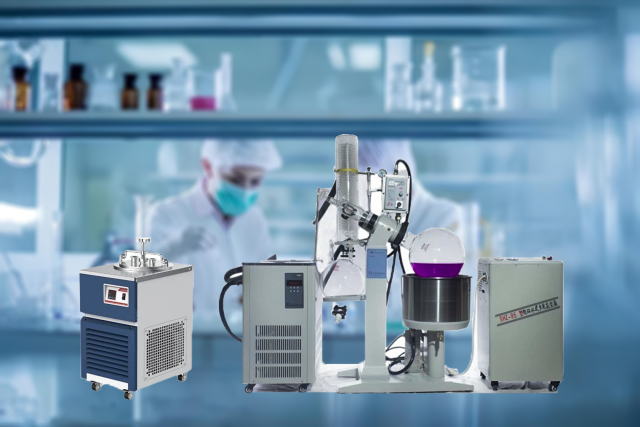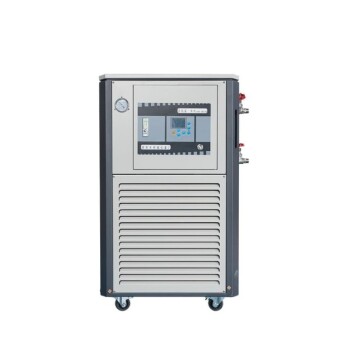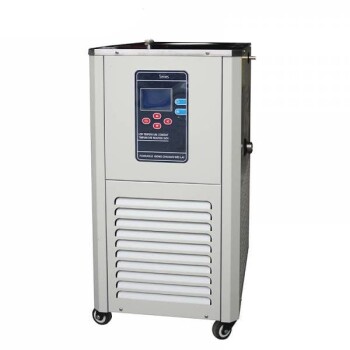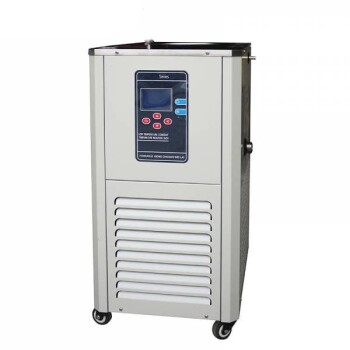Introduction to Rotavap
A rotary evaporator, or rotavap, is a laboratory device used for distillation. It is commonly used for removing solvents from a sample in a chemical reaction. The device works by rotating the sample under vacuum, which lowers the boiling point of the solvent and allows it to evaporate more easily. The rotating flask is typically heated by a water bath or oil bath, and the vapor is condensed and collected in a separate container. The rotavap is a crucial tool in the laboratory, and its efficiency can be greatly improved by using a recirculating chiller to maintain precise temperature control.
Table of Contents
Importance of Temperature Control
Accurate temperature control is critical during the extraction process when using a rotary evaporator (rotavap) in your laboratory. The process of extracting a sample requires precise temperature control to evaporate at a consistent rate. A chiller is a must-have tool for your rotavap to maintain the necessary temperature control.
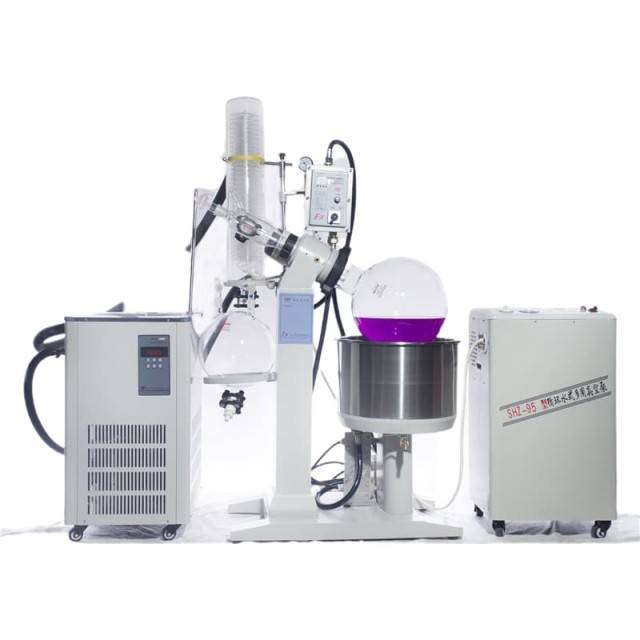
Consistent Evaporation Rates
Without a chiller, the temperature of the rotavap can fluctuate, leading to inconsistent evaporation rates. This inconsistency can lead to inaccurate results and potentially damage the sample. The temperature control provided by a chiller ensures that the sample is evaporated at a consistent rate, which is vital for producing accurate results.
Increase the Lifespan of Your Rotavap
In addition to producing accurate results, using a chiller can help to increase the lifespan of your rotavap. Temperature fluctuations can cause wear and tear to the machine. Using a chiller can reduce wear and tear by keeping the temperature constant, increasing the lifespan of your rotavap.
Choosing the Right Chiller
Choosing the right chiller for your rotavap is important. Different chillers have different cooling capacities and temperature ranges. It's essential to consider the size of your rotavap and the maximum temperature required for your experiments when selecting a chiller. A chiller with a cooling capacity of 500 W at 20°C will have a lower cooling capacity at 10°C.
Rule of 20
When shopping for a chiller, a good rule of thumb is to check the heating capacity of your rotovap’s heating bath. The chiller should be able to match the heating capacity of the bath in terms of cooling capacity at your desired setpoint temperature. The “rule of 20” is a good guide when deciding what temperature to set your chiller at. That is, your chiller should be able to provide a coolant stream that is at least 20°C below the boiling point of your solvent.
Conclusion
In conclusion, the importance of temperature control cannot be overstated when using a rotavap in your laboratory. A chiller is a must-have tool to achieve accurate and consistent results in your experiments. By maintaining precise temperature control, a chiller ensures that your sample is evaporated at the right rate, leading to reliable data and reducing the risk of sample damage. Choosing the right chiller is critical, and the rule of 20 is a good guide to follow when selecting a chiller.
How a Chiller Works with Rotavap
A chiller is an essential piece of equipment for any laboratory that uses a rotary evaporator or rotavap in their research or experiments. A rotavap works by evaporating solvents from a sample, which creates a vapor that is then condensed back into a liquid form. This process requires a constant flow of cold water to cool the condenser and prevent any vapor from escaping. Here's how a chiller works with a rotavap:
The Refrigeration Cycle
A chiller works by circulating a refrigerant through a closed-loop system that absorbs heat from the evaporator and then releases it through a heat exchanger. The refrigerant is then cooled and circulated back to the evaporator, creating a continuous cycle. This process is controlled by a thermostat that regulates the temperature of the refrigerant and ensures that the chiller is operating at the desired temperature.
Importance of a Chiller
Without a chiller, a rotavap would be unable to function properly, as the heat generated by the evaporator would quickly cause the condenser to become too hot, resulting in a loss of efficiency and potentially damaging the equipment.
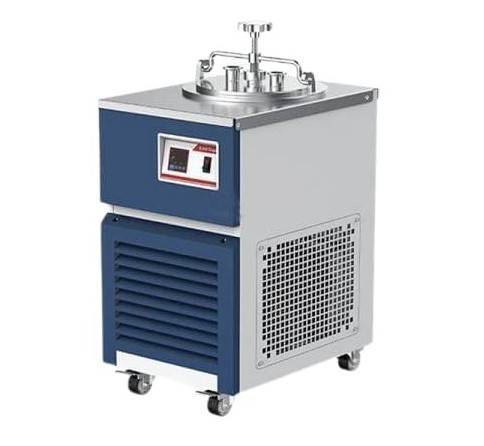
Cooling the Condenser
A chiller not only maintains the proper temperature of the condenser, but also reduces the amount of water needed to cool the system, making it more efficient and cost-effective in the long run. This is because the chiller cools the condenser, which in turn cools the vapor created during the evaporation process. Because the vapor is cool, it can easily condense back into a liquid form.
Features of Rotary Evaporator Chillers
Chillers for rotary evaporators must have a high cooling capacity because of the high temperature of the solvent vapor. It is not uncommon to find a chiller with a higher cooling capacity with a smaller temperature range, which for a rotary evaporator works perfectly. Chillers for rotary evaporators come in a variety of sizes, and one chiller can operate multiple rotary evaporators. In this case, a few rotary evaporators are daisy-chained together, and a single chiller cools down the circulating water.
In conclusion, a chiller is an indispensable tool for any laboratory that uses a rotavap. By providing a constant flow of cold water to cool the condenser, a chiller ensures that the rotavap can function properly and efficiently, while also reducing the amount of water needed for cooling. As such, investing in a chiller is a wise decision for any laboratory that wants to ensure the accuracy and reliability of their research.
Benefits of using a recirculating chiller
A recirculating chiller is a vital component of any rotavap setup. It is particularly useful in maintaining the condenser's temperature, which is crucial in the distillation of solvents and chemical mixtures. Here are some benefits of using a recirculating chiller:
Improved Quality and Consistency of Results
Using a recirculating chiller can help improve the quality and consistency of your results. It helps maintain stable temperature control, which is especially important when dealing with temperature-sensitive compounds. Any fluctuations in temperature can lead to failed experiments or inaccurate data.
Protection of Equipment
A recirculating chiller can help protect your equipment from damage caused by overheating or condensation. Overheating can lead to corrosion and reduced lifespan, while condensation can cause water damage. By keeping the temperature stable, the chiller can prevent these issues from occurring.
Time-Saving
Using a recirculating chiller can save you time by reducing the amount of time needed for the system to reach the desired temperature. With a chiller, you don't have to wait for the system to cool down before starting your experiment. This can significantly improve workflow and productivity.
Energy Efficiency
One of the most significant benefits of using recirculating chillers is their impact on energy consumption. By consuming less energy, the system is rejecting less heat into the environment, which reduces the burden on the HVAC system and saves costs.

Environmentally Friendly
Recirculating chillers promote a greener environment by reducing the impact on building systems and overall energy usage. They also require less maintenance, resulting in extended equipment life and an environmentally friendly workspace.
Versatile
Recirculating chillers can achieve temperature ranges of –25 °C to 130 °C and can also double as heaters. They are designed to be portable, making them suitable for cooling multiple types of laboratory equipment. They offer precise temperature control for laboratory and analytical equipment, delivering improvements in cost, size, noise, and environmental impact savings.
In conclusion, a recirculating chiller is an essential tool for any laboratory that uses a rotavap. It offers numerous benefits, including improved quality and consistency of results, protection of equipment, time-saving, energy efficiency, environmentally friendly, and versatile. By investing in a recirculating chiller, you can improve workflow and productivity while contributing to a greener environment.
Guidelines for Temperature and Chiller Sizing
When using a rotavap, it is important to have an appropriate chiller to regulate the temperature of the equipment and prevent overheating. However, choosing the right chiller can be a daunting task, as there are several factors to consider. Here are some guidelines for temperature and chiller sizing when using a rotavap:
Temperature Range and Uniformity
The first step in selecting a chiller is to determine the temperature range needed for your experiments. Consider the type of solvent used and the desired temperature range. It is also important to ensure temperature uniformity to achieve consistent results. Circulating chillers evenly distribute temperature through a closed loop of recirculated water, while waterless bead-based units can achieve uniform temperatures without the need for water.
Size and Capacity
Another important consideration is the amount of cooling power required. Cooling capacity is measured in watts or BTUs (British Thermal Units). Choose a chiller with a cooling capacity that matches your needs. It is also important to consider the size and amount of samples you will be cooling. Be sure to investigate chillers with dimensions that fit your technical requirements as well as your space limitations.
Safety Features
Look for safety features such as over-temperature protection, alarms, pressure and flow rate monitoring to ensure consistent temperatures, and automatic shutoff, leak detection, and proper ventilation to ensure the safe operation of the chiller.
Selecting the Chiller
When selecting a chiller, consider the size of the rotavap, the type of solvent, and the desired temperature range. The chiller should have enough cooling capacity to handle the heat load generated by the rotavap, and the temperature control should be precise and stable to achieve consistent results. Additionally, ensure that the chiller is compatible with the rotavap and its accessories, such as the tubing and fittings.
Calculating Chiller Size
Calculating the size of chiller required for your rotavap is relatively simple if you know the incoming water temperature, the water temperature required, and the flow rate. The general sizing formula is as follows:
- Calculate Temperature Differential (ΔT°F) ΔT°F = Incoming Water Temperature (°F) – Required Chill Water Temperature
- Calculate BTU/hr. BTU/hr. = Gallons per hr x 8.33 x ΔT°F
- Calculate tons of cooling capacity Tons = BTU/hr. ÷ 12,000
- Oversize the chiller by 20% Ideal Size in Tons = Tons x 1.2
By following these guidelines, you can ensure that your rotavap and chiller work together seamlessly to deliver accurate and reliable results.
Using one chiller for multiple rotavaps
A chiller is an essential piece of laboratory equipment that helps to cool down and maintain the temperature of liquids in a variety of applications. When it comes to using a rotavap, a chiller is a must-have because it helps to maintain the temperature of the sample and prevents overheating. The good news is that one chiller can be used for multiple rotavaps, which is a cost-effective solution for laboratories with multiple units.
Benefits of using one chiller for multiple rotavaps
Using one chiller for multiple rotavaps provides several benefits. First, it reduces the cost of purchasing additional chillers for each rotavap unit. Second, it reduces the amount of space required to house multiple chillers, which is especially important for smaller laboratories. Third, it simplifies the maintenance and repair process since only one chiller needs to be serviced instead of multiple units.
Connecting multiple rotavaps to one chiller
Connecting multiple rotavaps to one chiller is a straightforward process that involves using hoses to link the units to the chiller. It is important to ensure that the hoses are the correct size and length for each rotavap unit. Additionally, it is important to ensure that the connections are secure and leak-free to prevent any loss of cooling capacity.
Managing temperature control for multiple rotavaps
When using one chiller for multiple rotavaps, it is important to manage temperature control effectively. This can be achieved by using a multi-channel temperature controller, which allows for independent temperature control of each rotavap unit. Alternatively, a single temperature controller can be used for all units, but this requires careful monitoring to ensure that each unit is at the correct temperature.
Conclusion
Using one chiller for multiple rotavaps is a cost-effective and practical solution for laboratories with multiple units. It reduces costs, saves space, and simplifies maintenance and repair. By ensuring that the connections are secure and using a multi-channel temperature controller, laboratories can effectively manage temperature control for each unit.
Conclusion: Efficiency and Reliability of Rotavap with Chiller
In conclusion, using a chiller with your rotavap is a must for achieving efficiency and reliability in your laboratory processes. A chiller helps to maintain the necessary low temperatures required for the evaporation process to occur effectively. It also helps to prevent overheating and damage to your equipment, ensuring that your rotavap lasts longer. Furthermore, using a recirculating chiller saves you money in the long run by reducing energy consumption and minimizing water usage. Overall, a chiller is an essential investment for any laboratory looking to improve its rotavap processes.
Related Products
- Vacuum Cold Trap Direct Cold Trap Chiller
- Vacuum Cold Trap Chiller Indirect Cold Trap Chiller
- 5L Heating Chilling Circulator Cooling Water Bath Circulator for High and Low Temperature Constant Temperature Reaction
- 20L Heating Chilling Circulator Cooling Water Bath Circulator for High and Low Temperature Constant Temperature Reaction
- 5L Chilling Circulator Cooling Water Bath Circulator for Low Temperature Constant Temperature Reaction Bath
